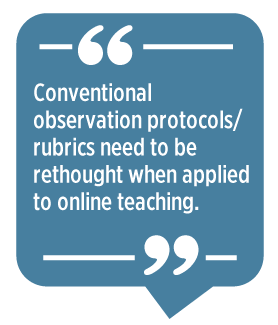|

Experts in online teaching have begun to explore the value of teaching observations for online courses. Suddenly, however, many of us have found ourselves teaching online for the first time. With so many educators finding themselves teaching in an unfamiliar mode, feedback is as important as ever to ensure that student learning is successful. Observing online teaching presents some challenges to the teacher and to the observer, but it also offers opportunities to experiment with new methods and assess their effectiveness.
Classroom observations in this new environment need to be rethought because, as Bennet and Barp (2008) note, “many aspects of peer observation do not simply ‘translate’ to online.” In this article, we share some of our recent experiences as evaluators of online teaching. In the last several months, we have observed courses in different formats—asynchronous and synchronous; using Canvas, Zoom, and Teams; live and recorded—and in our different capacities (both as peer observers and outside consultants).
The Good, the Bad, and the Synchronous
Let’s start with some of the benefits of observing courses online. First, the observer does not need to be at the same institution, or even on the same continent, where the course is being taught. In addition, if the observation is of a recording of a class, the observation can be completed at any time. Perhaps most important, while being observed can be nerve-wracking for the teacher and distracting to the students, these effects can be minimized when the observer’s presence in the class is not obvious (Bennet & Barp, 2008).
 Of course, there are downsides to conducting observations online. If the observer is not physically present, the teacher’s rapport with the students—and the students’ interactions with each other—cannot be fully experienced. If all classes are recorded, a teacher may feel that every class period is potentially subject to evaluation, leading to anxiety. Another issue is that most teachers are learning new methods for teaching online while using them at the same time; it is a steep learning curve. Finally, it may not be fair to evaluate a teacher’s performance based only on an online observation, if online teaching is a temporary substitute for their normal mode of instruction. Of course, there are downsides to conducting observations online. If the observer is not physically present, the teacher’s rapport with the students—and the students’ interactions with each other—cannot be fully experienced. If all classes are recorded, a teacher may feel that every class period is potentially subject to evaluation, leading to anxiety. Another issue is that most teachers are learning new methods for teaching online while using them at the same time; it is a steep learning curve. Finally, it may not be fair to evaluate a teacher’s performance based only on an online observation, if online teaching is a temporary substitute for their normal mode of instruction.
Observing a synchronous course presents a unique set of challenges. If the instructor plans to use Zoom’s break-out rooms or Team’s groups and the observation is in real time, the instructor must decide what the observer will see. If the observer is put into a small group, they see how students interact when the teacher is not present (and can thus comment on the effectiveness of the instructor’s planned group activities) but is no longer observing the instructor. However, if the observer is watching a recording of the Zoom session, they will only see what is happening in the main room; in this situation, the instructor should keep one of the groups in the main room so that the recording will show an example of small-group interaction.
Where Existing Observation Protocols Fall Short
A number of criteria on conventional observation protocols/rubrics need to be rethought when applied to online teaching. Most obviously, a question like “How does the instructor support the lesson with technology?” is problematic when the entire class is online. We have found that many instructors are given specific platforms (LMS, e-text) to teach with. Is the teacher expected to go beyond the activities built into these packages and use outside apps?
Often, we ask “Are students engaged (or on task)?” An issue with synchronous online learning is whether students should be required to keep their cameras on, as many students may feel unsafe or embarrassed sharing their living situation with their peers. As a result, the observer may not see every student’s face, and even with the camera on, the observer cannot rule out that a student is multitasking.
“Is groupwork used appropriately?” In an online class, student-student interaction should continue to be emphasized over teacher-centered instruction, and groupwork is possible on platforms such as Zoom. However, it is more difficult for the observer to assess the effectiveness of groupwork over video than in a physical classroom. The instructor can mediate this by appointing a reporter for each group, so that in the wrap-up to groupwork, the observer gets a feeling for the range of work conducted by the entire class.
Finally, evaluating “teacher presence” and “rapport” is going to be different online. Traditional criteria such as body language and movement around the classroom are not relevant. Observers will need to be fair when evaluating an instructor’s home environment, and teachers should not be judged if their teaching is interrupted by a small child, a barking dog, or street noises.
Adapting Your Protocol: Best Practices for Online Observations
Jones and Gallen (2016) note that best practices for online courses have yet to be developed, so in this section we outline some ideas. Although some aspects of class observations need to be adapted to the new online mode, many of the common criteria on observation protocols can continue to be assessed. When observing an online class, look for the following:
Observations Are Planned
Instructors need advance knowledge of the observation so that they can decide how to accommodate an observer in groupwork. Even if all of an instructor’s online sessions are recorded, they should be allowed to know which recording is to be evaluated.
Learning Objectives Are Clear
More than just a “passing thought” at the start of class, it is especially important that objectives are clear and easy for students to understand in an online course, so that both teacher and students are motivated to remain focused on the goal of the lesson.
Activities Are Introduced and Wrapped Up Effectively
It’s important to give feedback on the way the instructor facilitates the beginning of class with students logging in, introduces the topic/theme/lesson for the day, and ends class time. Chatting with the students before the official start of class has taken on new meaning, as many teachers begin by “checking in” with students about their physical and mental well-being, addressing social-emotional aspects of teaching more than they might in person.
Class Time Is Used Wisely
Online classes should actively engage with material rather than reading or working silently.
Instructions Are Clear
Detailed instructions for groupwork take time, but they are even more important in online learning. When students enter a Zoom room or a Teams group, they need to start the tasks with minimal doubt, because it is more difficult to ask for help once they have been put into groups.

Activities Are Scaffolded
Students are not only at different levels of language development, but also have varying access to and ease with technology, making scaffolding especially important in the online mode. Examples include giving clear written instructions or a link to a video on how to use a particular application or software program, breaking down lengthy projects into manageable “chunks,” and providing examples of assignments or activities so students know what is expected.
Activities Are Paced and Varied
A synchronous online class can follow the same pace as an in-person class (say, 10 minutes per activity) and should vary between teacher- and student-centered activities. Teaching online does not mean lecturing—students need to interact with each other.
Language Is Contextualized in a Meaningful Way
Students not only know the objective for an online activity, but also how they would use it outside the classroom in the “real world.”
Teacher Adapts to Students’ Learning Styles
Online platforms make it easy to adapt material for different types of learning. Enabling the chat function of Zoom allows students to type their responses; this lets students participate who would otherwise be silent in a physical classroom. Recording the class and making the video accessible to students afterwards helps those who need to listen to instructions or information more than once. Students are able to share pictures, graphics, and other visual aids more easily and can be provided with a wide range of resources to support their learning.
Target Language Is Used
The observer can continue to expect that an appropriate percentage of class time is taught in the target language.
Unless this is a fully online program, high-stakes performance evaluation should not be based on online teaching. Student engagement is likely to be different, and students and teachers both are experiencing unprecedented anxiety, so this is not the time to “hold teachers accountable” to unrealistic standards. Instead of using the “evaluation model” of observations, this is an opportunity to use the “developmental” and “peer-review” models of Gosling (2002)—to build community among teachers, encourage them in difficult situations, engage in conversations about pedagogy, and improve teaching methods.
The feedback received from observations is part of an instructor’s professional development journey. Retooling the protocols for observations ensures that both the observer and the instructor engage in productive and effective conversations about teaching in this unprecedented time. Every school, institute, and program should take a closer look at their observation protocols and invite all involved in teaching to rethink and adapt them in their own context.
References
Bennet, S., & Barp, D. (2008). Peer observation – a case for doing it online. Teaching in Higher Education, 13, 559–570.
Gosling, D. (2002). Models of peer observation of teaching. Higher Education Academy. https://www.researchgate.net/publication/267687499_Models_of_Peer
_Observation_of_Teaching
Jones, M. H., & Gallen, A.-M. (2016). Peer observation, feedback and reflection for development of practice in synchronous online teaching. Innovations in Education and Teaching International, 53, 616–626.
Dinorah Sapp is an ESL teacher and professional development specialist. She taught in the University of Mississippi’s Intensive English Program for 12 years and was a U.S. Department of State English Language Fellow in Chile. Currently, she is a contractor for the U.S. Embassy in Chile and an ESL teacher in Bloomington, Indiana.
Christopher Sapp is associate professor of Germanic linguistics at Indiana University. He was previously professor of German at the University of Mississippi, where he served as director of the basic German program and director of graduate studies. |